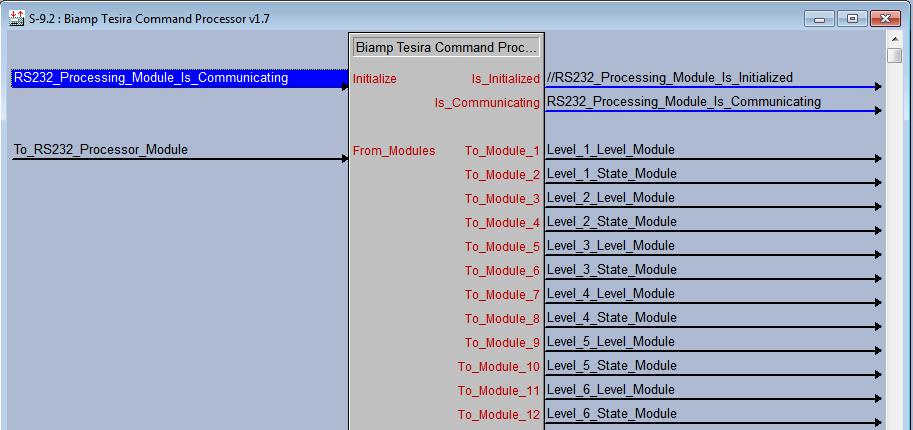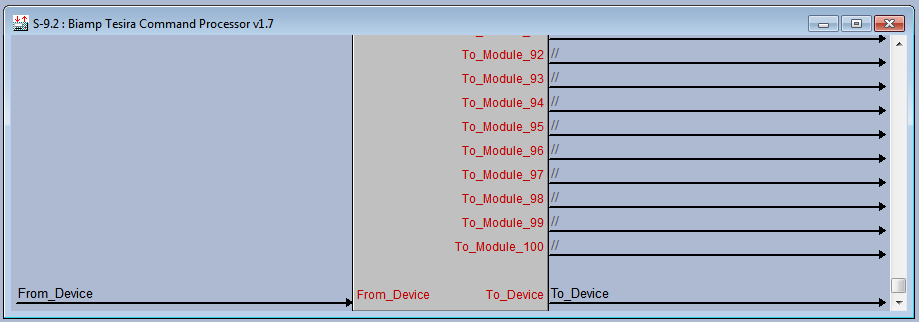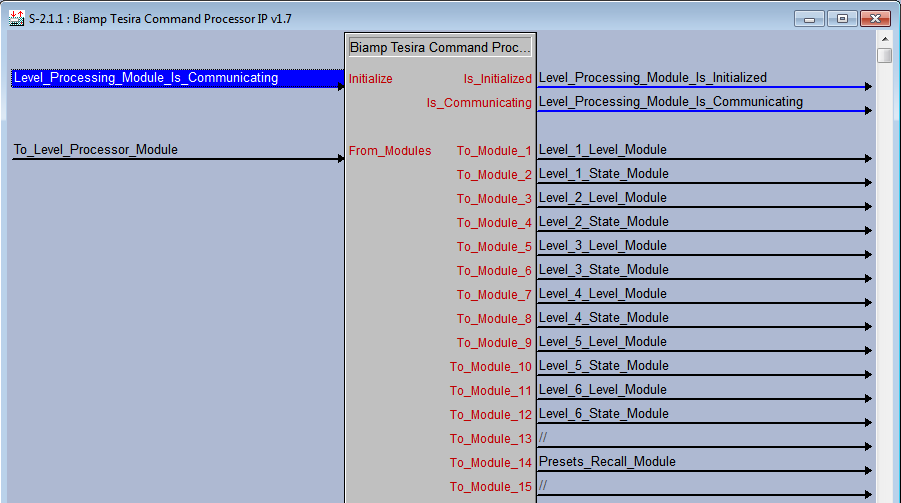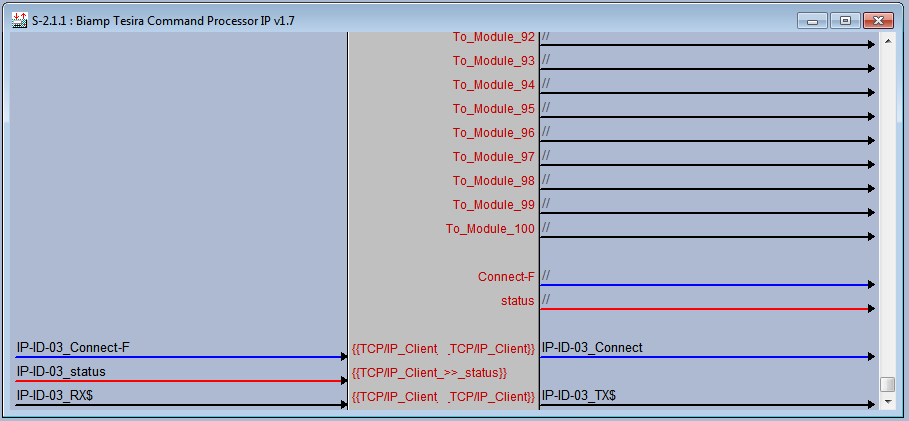Crestron Tesira Module v1.7 - deep dive
The v1.7 Tesira module suite was developed on and for the Crestron 2-Series control processors and has been deprecated as of January 2019. The 2-Series processors have since been replaced by 3-Series processors in the market. It is important to understand that the existing v1.7 Tesira module suite will be retired in place for legacy support of Crestron 2-Series systems. This module suite can function on 3-Series processors but is not suggested especially for VoIP control functionality. If for some reason v1.7 modules are required, please contact Biamp Support via email or phone for further details.
Command Processor
The deprecated v1.7 Tesira module suite download included two example programs. As detailed in the naming, the basic 'v1_7' file includes a Command Processor for RS-232 communication and the 'ip_v1_7' file includes a Command Processor for IP communication. We'll look at each of these separately.

RS-232
Let's take a look at the RS-232 Command Processor as displayed in the Detail View of SIMPL Windows:


Important items to note:
- The RS-232 Command Processor supports up to 100 function modules.
- Each RS-232 Command Processor pairs with a single COM port or two-way serial driver of a Crestron control processor.
- Best results have been observed when COM 1 of the processor is utilized.
- The 'To_Device' and 'From_Device' signals shown allow connection to and from the two-way serial driver.
- It is important that there is a signal connecting 'Is_Communicating' feedback to 'Initialize' control input.
- This connection enables the auto-recovery mechanism.
- If RS-232 communication is dropped or suspended for some reason, once that communication is restored, the Command Processor will re-initialize all connected function modules.
- It is good practice to add a signal name to the 'Is_Initialized' feedback.
- This will provide visibility of the Command Processor being fully initialized.
- If the Command Processor is fully initialized, that means that all attached function modules have been initialized.
- The initialization of the function modules occurs in a linear fashion from Module_1 to Module_100.
- If for some reason function module 3 of 62 does not initialize, that means that function modules 4-62 will not attempt initialization and subsequently the Command Processor will not report as fully initialized.
- The most common error preventing initialization is related to instance tag typos.
IP
Let's take a look at the IP Command Processor as displayed in the Detail View of SIMPL Windows:


Important items to note:
- The IP Command Processor supports up to 100 function modules.
- Each IP Command Processor pairs with a single TCP/IP Client of a Crestron control processor.
- All five signals for TCP/IP Client communications must be properly plumbed in.
- It is important that there is a signal connecting 'Is_Communicating' feedback to 'Initialize' control input.
- This connection enables the auto-recovery mechanism.
- If IP communication is dropped or suspended for some reason, once that communication is restored, the Command Processor will re-initialize all connected function modules.
- It is good practice to add a signal name to the 'Is_Initialized' feedback.
- This will provide visibility of the Command Processor being fully initialized.
- If the Command Processor is fully initialized, that means that all attached function modules have been initialized.
- The initialization of the function modules occurs in a linear fashion from Module_1 to Module_100.
- If for some reason function module 3 of 62 does not initialize, that means that function modules 4-62 will not attempt initialization and subsequently the Command Processor will not report as fully initialized.
- The most common error preventing initialization is related to instance tag typos.
Supervision & load balancing
Basic supervision
Each Command Processor has two layers of 'watchdog' supervision built in.
- Every 30 seconds, the Command Processor will poll the Tesira system for its current firmware version (DEVICE get Version).
- If the Tesira device does not respond, the Command Processor will attempt to re-initialize.
- Every 30 seconds, the Command Processor will send a subscription request to the first Function Module that supports subscriptions.
- It is normal to see Tesira respond with "Error - already subscribed" as this confirms the subscription exists.
- If the Tesira system does not respond, or responds with an '+OK', the Command Processor will attempt to re-initialize.
Once TTP commands are received by a Tesira system, they are passed to the appropriate Tesira device within that system via the Tesira Control Network. Tesira uses the instance tag to pass the TTP commands to the correct device.
Enhanced supervision
Though not always necessary, there are systems that require per device supervision.
Let's consider a small example system that includes a Tesira Server-IO in the IDF closet and a TesiraFORTE VI installed down the hall in the Conference Room. The TesiraFORTE VI provides VoIP functionality for the Conference Room. The third party Crestron control processor is also located in the IDF closet and is connected to the same control network as the Tesira system. Since we have two Server class Tesira devices, the Crestron code can include an IP Command Processor for each respective Tesira device. This will employ the 'watchdog' supervision detailed above on each respective Tesira device to our advantage. In the event of a power outage at the TesiraFORTE, the respective IP Command Processor will detect loss of communication and re-initialize once the device powers back up.
This same technique can be applied for per partition supervision. The assumption here is that the project has multiple partitions that may be updated throughout the commissioning period. As a partition or file is uploaded, existing subscriptions will be dropped. The per partition IP Command Processors would detect the lost subscription for the respective partition and re-initialize as needed.
Load balancing
When we consider larger system designs which require hundreds of control points, we will need to use multiple Command Processors to accommodate all of the Function Modules. An example system may include 32 touch panels, one or more Crestron control processor(s) and nine Tesira Server-IO. For this example, strategically balancing the room/device specific controls across nine Command Processors would strategically load balance communications as well as employ per device supervision.

